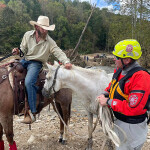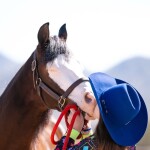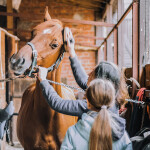Horse Health is Sponsored By: Cornerstone Equine Veterinary Services
We’re all familiar with the risks of grazing horses on lush spring grasses, but fall pastures can pose a risk of laminitis to horses as well. Understanding a bit about grasses and how they grow is helpful in keeping at-risk horses safe as the weather changes from summer to fall.
Non-structural carbohydrates, which are starches, simple sugars, and fructans, are produced through plant photosynthesis during the daylight and give the plant energy to grow. NSC’s are in highest concentrations when plants are growing quickly, when exposed to direct sunlight, when night time temperatures are below 40F, and after stress. Stress can be from drought, killing frost, poor soil fertility, some herbicide use, and conditions that restrict plant growth, such as overcast skies. Cool weather grasses tend to have more NSC’s as fructans whereas warm season grasses tend to have NSC’s as starches. This difference becomes important in horses at risk for laminitis.
While NSC’s are great for plants, they can put some horses and ponies at risk for laminitis. When NSC’s are consumed in large amounts the stomach can’t process it all and some NSC’s spill over into the hindgut. This causes an increase in acidity of the cecum (hindgut) which leads to a cascade of events that can end in laminitis, more commonly known as founder.
Prevention
Excellent pasture management is an essential part of avoiding fall pasture laminitis. Testing your horse’s hay and pasture for NSC’s can help keep an at-risk horse’s diet in the ideal range of less than 10% NSC. Remember to include any grain or mixed feed your horse consumes. Body Condition Score, or BCS, is a measurement of how fat a horse is and should be between 4 and 6, on a scale of 1 to 10. Obese horses’ with a BCS of 7-9 are at high risk of laminitis. UT Extension has an excellent publication (SP782, “Equine Welfare Series: The body Condition Scoring System) or ask your local vet for help in assessing your horse’s weight. There are medical conditions that put horses at risk of laminitis as well. Those with insulin resistance, equine metabolic syndrome, and pituitary pars intermedia dysfunction (also known as PPID or Equine Cushing’s disease) are at higher risk for laminitis. These horses benefit from close communication with your local vet to minimize risks. Keeping horses in a dry dirt lot, or stall, during the day then turning them out to pasture overnight reduces consumption of NSC’s. Pastures are lowest in NSC’s from 2-9 AM and highest in the afternoon. Remember: more sun=more photosynthesis=more NSC’s. Grazing muzzles used part-time can slow down eating while on pasture. Buying a brightly colored one makes it easier to find when your smart pony wriggles out of it!
There are many tools to aid in avoiding fall laminitis. Keep your horse and pastures in top condition, evaluate the level of NSC’s in your horse’s daily intake, and avoid pastures during times when there is likely to be high NSC levels.








